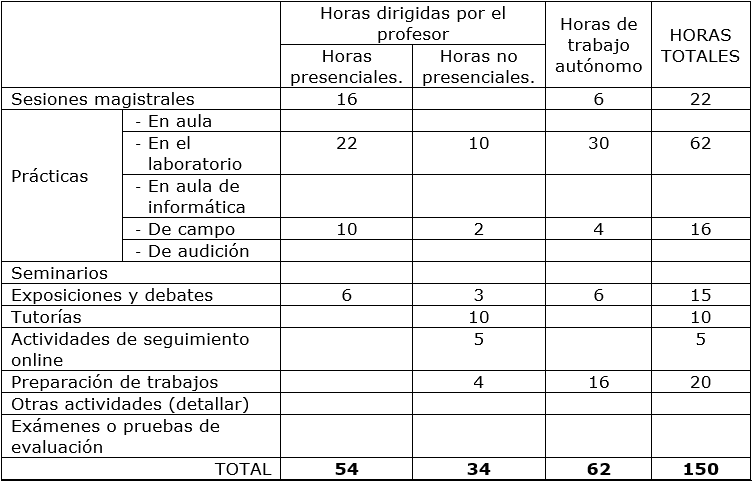LABORATORY OF AUDIOVISUAL TOOLS FOR ANTHROPOLOGY
GRADO EN ANTROPOLOGÍA
Curso 2022/2023
1. Datos de la asignatura
(Fecha última modificación: 24-05-22 13:58)- Código
- 109819
- Plan
- 2020
- ECTS
- 6.00
- Carácter
- OBLIGATORIA
- Curso
- 2
- Periodicidad
- Segundo Semestre
- Idioma
- ESPAÑOL
- Área
- SOCIOLOGÍA
- Departamento
- Sociología y Comunicación
- Plataforma Virtual
Datos del profesorado
- Profesor/Profesora
- Milagros García Gajate
- Grupo/s
- Único
- Centro
- Fac. Ciencias Sociales
- Departamento
- Sociología y Comunicación
- Área
- Comunicación Audiovisual y Publicidad
- Despacho
- 422
- Horario de tutorías
- Online. Apointment request by email.
- URL Web
- https://produccioncientifica.usal.es/investigadores/56841/detalle
- gajate@usal.es
- Teléfono
- 923 29 44 00 ext.6796
2. Sentido de la materia en el plan de estudios
3. Recomendaciones previas
4. Objetivo de la asignatura
GENERAL OBJECTIVES
- Knowledge of useful audiovisual tools as a complement to the anthropologist's field notebook
- Knowledge of audiovisual tools for the dissemination of the anthropological research results
SPECIFIC OBJECTIVES
- Acquisition of knowledge that allows critical reflection on the use of audiovisual tools and their possible innovations in anthropological work.
- Acquisition of knowledge and skills for the management of audiovisual technologies applied to anthropological practice and research, in all data collection, analysis and presentation processes.
- Development of the ability to use audiovisual tools in theoretical and practical research
5. Contenidos
Teoría.
PART 1Anthropology of communication. Analysis of the different media, technologies, and platforms: Anthropology of communication, Visual anthropology, Sound antropology, Antrhopological cinema.
PART 2Tools for anthropology:
- Three steps or funtions:
- Recording / colecting
- Photography. Tools and strategies.
- Sound recording. Tools and strategies.
- Website. Tools and strategies.
- Analysing examples.
- Knowledge dissemination / difusion in different media and platforms.
- Recording / colecting
- Some media, some examples:
- MORE TRADITIONAL
- NEW FORMS
6. Competencias a adquirir
7. Metodologías
8. Previsión de Técnicas (Estrategias) Docentes

9. Recursos
Libros de consulta para el alumno.
- Ardévolo, E. (1995) La mirada antropológica o la antropología de la mirada: De la representación audiovisual de las culturas a la investigación etnográfica con una cámara de video. Tesis doctoral. Universidad Autónoma de Barcelona.
Ardevolo, E. (2004) 213 – 226
- Carvalho, C. (2011) Audiovisual Instruments in Ethnographic Research. In Readings in Methodology: African Perspectives. Ed. African Books Collective Pags. 163-172
- Lisón Tolosana, C. (1992). Individuo, estructura y creatividad: etopeyas desde la antropología cultural. Ediciones Akal.
- Lisón Tolosana, C., & Novajra, A. M. (Eds.). (2007). Introducción a la antropología social y cultural: teoría, método y práctica. Tres Cantos (Madrid): Akal.
- Montes, S. y Muñoz Carrión, A. (1978) Modelo comunicacional para el análisis antropológico. En Reis: Revista Española de Investigaciones Sociológicas (3). Págs. 111-120
- Muñoz Carrión, A. (2007) Tácticas de comunicación juvenil: intervenciones estéticas. En Revista de estudios de Juventud (78). Págs. 11-24
- Muñoz Carrión, A. (2008) El patrimonio cultural material y el inmaterial: buenas prácticas para su preservación. En Mediaciones sociales (3) Págs. 495-534
- Muñoz Carrión, A. y Timón Tiemblo, M.P. (2018) La imposibilidad de separar lo inmaterial de lo material en las manifestaciones cuturales. En Erebea: Revista de Humanidades y Ciencias Sociales. Págs. 45-60
- Peterson, M.A. (2003) Anthropology and Mass Communication: Media and Myth in the New Millennium. Berghahm Books.
- Velasco Gutiérrez, M.J. (2010) Las imágenes del patrimonio cultural inmaterial en España, 1940-2010. Tesis doctoral.
Otras referencias bibliográficas, electrónicas o cualquier otro tipo de recurso.
Further bibliografy will be available in Studium.
10. Evaluación
Consideraciones generales.
This subject has a practical character, that is why a continuous evaluation has been proposed.
ORDINARIY
- Active participation 15 %
- Theoretical commentaries 15 %
- Weekly practices 30 %
- Final project 40 %
The fraudulent use of bibliographic citations is considered illegal; therefore, the student will have a score of 0 point as final grade in the corresponding call. In case it is a groupal work, each student will have 0 points.
The students that choose a non face-to-face evaluation must submit the same work and within the same deadlines. As they do not have active participation in class, the maximum score cannot be 10 points.
It is needed to pass every and any part of the evaluation system.
EXTRAORDINARY
The details will be specified according to the evaluation modalities and the peculiarities of each case. Students who do not pass in the ordinary call should contact the professor to know the details for the extraordinary call.
Criterios de evaluación.
Present the works following the corresponding indications.
Theoretical knowledge
Analitical skills
Capacity for effort and improvement
Creativity and originality
Works presented out of the platform or out of time are not going to be condired.
Instrumentos de evaluación.
- Active participation
- Theoretical commentaries
- Weekly practices
- Final project
Recomendaciones para la recuperación.
Each student will have their own specific recommendations.


